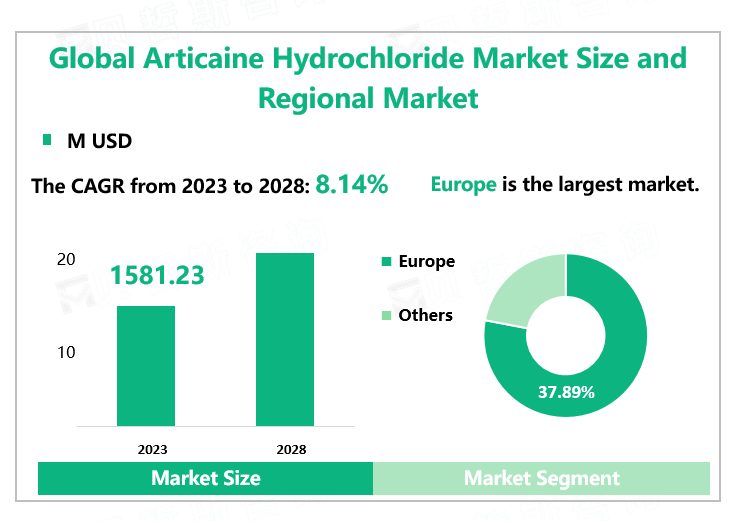Global Articaine Hydrochloride Market Overview
According to Global Market Monitor, the global articaine hydrochloride market size will reach $1581.23 million in 2023 with a CAGR of 8.14% from 2023-2028.
Articaine Hydrochloride Introduction
Articaine hydrochloride is one of the local anesthetics which blocks nerve conduction when infiltrated around the nerve. Articaine causes nerve impulse conduction by binding to sodium ion channels, which in turn slow down the nerve impulse propagation and hence reduces the rise in nerve action potential that reduces the sensation at the site of drug injection. Aticacaine hydrochloride is often used in combination with the vasoconstrictor adrenaline to relieve pain during minor operations such as dental surgery. Articaine induces anesthesia only for an hour, as its half-life time is 1.8 hours, and after that, it is excreted out of the body via urine.
According to WHO, it is estimated that approximately 2.3 billion people suffer from dental caries affecting permanent teeth. Periodontal disease has become the third largest disease endangering human health after malignant tumors and cardiovascular and cerebrovascular diseases. Especially in developing countries, the prevalence of periodontal disease is very high, and the prevalence of dental caries continues to increase (especially for urban residents). The continued increase in the incidence of periodontal disease has led to an increase in related dental surgery. The continuous rise in the incidence of periodontal disease has led to an increase in related dental procedures, which is expected to stimulate the growth of the articaine hydrochloride market.

Regional Development of Atecaine Hydrochloride is Uneven.
The articaine hydrochloride market in Europe was the largest region with a market share of 37.89% in 2022 and is expected to develop continuously due to the increasing demand and focus on dental treatments. The growing awareness of preventative and corrective treatment in European countries is also one of the factors driving the growth of this market.
Ateticaine hydrochloride, as a local oral anesthetic, has a good anesthetic effect, but the price is high. In some low-income areas, they may find it difficult to afford higher-priced medicines and instead choose alternative medicines with similar effects. Local anesthetics such as Lidocaine, Mepivacaine, Prilocaine, etc. can be used as oral local anesthesia. Lower prices for alternative medicines may attract more consumers, especially in developing countries. This may limit the development of the arcticaine hydrochloride market.
|
Drivers |
Increasing incidences of dental caries and other periodontal diseases |
|
Development of dental anesthesia |
|
|
Vigorous research and development efforts |
|
|
Restraints |
Alternative local anesthesia available in developing countries |
|
High costs and unfavorable reimbursement policies |
We provide more professional and intelligent market reports to complement your business decisions.